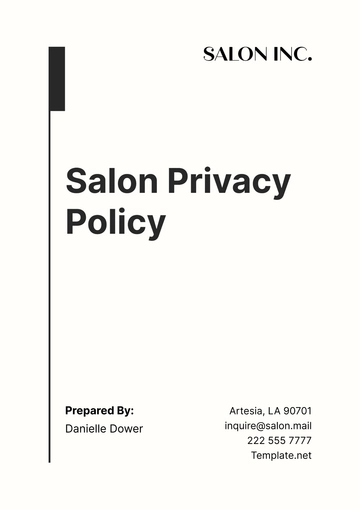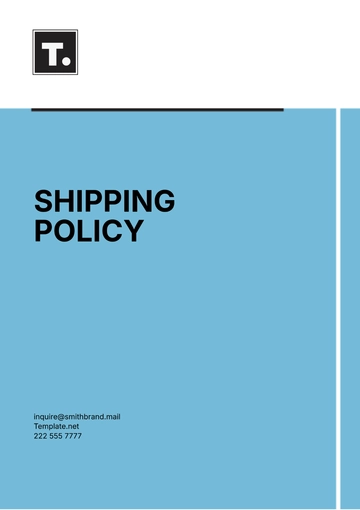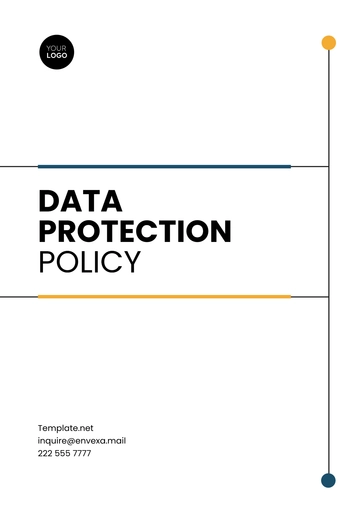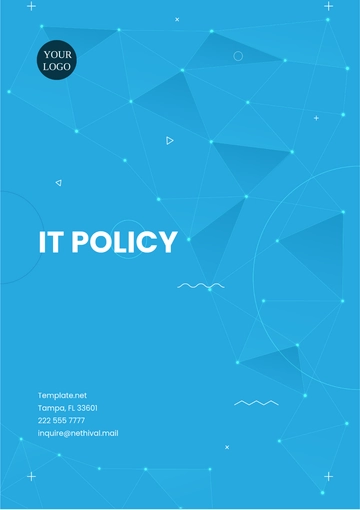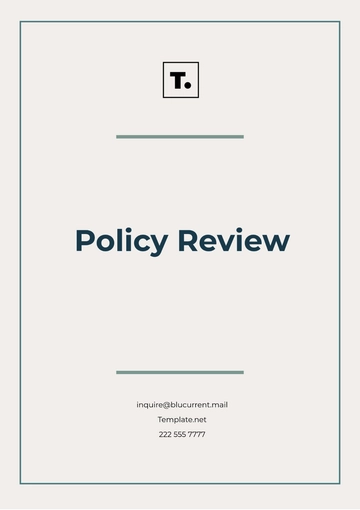Free Sales Client Retention Policy & Procedure

1. Purpose
The purpose of this Sales Client Retention Policy & Procedure is multifaceted and pivotal in ensuring the long-term success of our [Your Company Name]. It is designed to:
1.1 Foster Long-Term Satisfaction
Our foremost objective is to nurture long-term satisfaction among our valued clients. By implementing this policy, we aim to create an environment where clients not only receive exceptional service but also consistently experience the value of our products and services throughout their engagement with our company.
1.2 Retain Valued Clients
Retaining clients is not merely a financial concern; it is a testament to the quality and commitment of our organization. This policy outlines a strategic approach to client retention that goes beyond transactional interactions, focusing on building lasting partnerships.
1.3 Establish Clear Guidelines
By providing a comprehensive framework, this policy sets clear guidelines for all employees. It ensures that everyone understands their roles and responsibilities in the client retention process. Clarity in these guidelines is essential to maintaining consistency in client interactions.
1.4 Provide Excellent Service
Exceptional service is the cornerstone of client retention. This policy underscores the significance of consistently delivering outstanding service that exceeds client expectations. It emphasizes proactive measures to identify and meet client needs.
2. Scope
This Sales Client Retention Policy & Procedure applies comprehensively across our organization. It encompasses all employees and departments involved in client interactions, recognizing that every interaction is an opportunity to enhance client satisfaction and retention. The scope includes, but is not limited to:
2.1 Sales
[Your Company Name] sales teams play a pivotal role in initiating and maintaining client relationships. They are responsible for understanding client needs, offering tailored solutions, and continuously nurturing these relationships.
2.2 Customer Support
Our dedicated customer support teams are instrumental in addressing client inquiries, resolving issues, and providing ongoing assistance. Their interactions are vital in ensuring client satisfaction and problem resolution.
2.3 Account Management
Our account management teams are responsible for the ongoing relationship with clients. They work closely to understand changing client needs, identify upsell and cross-sell opportunities, and ensure that clients receive the highest level of service throughout their engagement with us.
2.4 All Employees
This policy is not limited to specific departments. It is the responsibility of every employee to uphold the principles outlined herein and contribute to the overall success of our client retention efforts.
3. Policy
3.1 Client Segmentation
At [Your Company Name], we recognize that not all clients are the same. To better serve our diverse client base, we employ a client segmentation strategy that categorizes our clients into distinct groups based on various factors, including their needs, value to the company, and potential for growth. This segmentation approach serves as the foundation for tailoring our client retention strategies effectively.
High-Value Clients |
|
Medium-Value Clients |
|
Low-Value Clients |
|
3.2 Client Engagement
Effective client engagement is a cornerstone of our client retention strategy. To achieve this, we commit to the following principles:
Maintain Open Lines of Communication: We proactively initiate regular check-ins with our clients to ensure that we are responsive to their evolving needs. Communication is key to understanding their concerns and preferences.
Active Listening: We prioritize active listening when engaging with clients. This means not only hearing their feedback but also taking concrete actions to address their concerns promptly and effectively.
Personalized Solutions: We acknowledge that each client is unique. Therefore, we strive to provide personalized solutions and offers that align with their preferences and requirements. This personal touch enhances the overall client experience.
3.3 Client Feedback and Surveys
To continually improve our services and products, we place significant importance on gathering client feedback through various channels. We follow these principles:
Regular Feedback Collection: We conduct client feedback surveys on a quarterly basis to gauge satisfaction levels and gather valuable insights. These surveys ensure that we stay attuned to our clients' evolving needs.
Thorough Analysis: Feedback collected through surveys and direct communication is thoroughly analyzed. This analysis allows us to identify trends, areas for improvement, and opportunities to enhance the client experience.
3.4 Service Quality Assurance
Delivering quality products and services is non-negotiable for us. Our commitment to service quality includes the following:
Establishing Quality Standards: We have set stringent quality standards for our products and services. These standards act as benchmarks for performance and quality.
Regular Quality Audits: To ensure that we meet or exceed these standards, we conduct regular quality audits. These audits help us identify areas for improvement and implement necessary changes.
3.5 Client Issue Resolution
In the event of client issues or complaints, we adhere to a structured and client-centric resolution process:
Process | Description |
|---|---|
Acknowledgment | We acknowledge client issues promptly, usually within 24 hours. |
Thorough Investigation | We conduct a thorough investigation into the issue to understand its root causes and impact. |
Resolution Plan | We commit to providing a resolution plan within 48 hours that outlines the steps we will take to address the issue. |
Follow-up | After resolution, we follow up with clients to ensure their satisfaction and to gather feedback on the resolution process itself. |
4. Procedure
4.1 Client Communication
4.1.1 Regular Client Meetings
To ensure effective client communication and relationship management, we follow a structured approach:
Regularly schedule meetings or check-ins with clients: We proactively schedule regular meetings or check-in sessions with our clients. These interactions provide an opportunity to discuss their evolving needs, address concerns, and offer assistance where needed.
Maintain client profiles with relevant information: To personalize our interactions, we maintain comprehensive client profiles that include key information such as their history, preferences, and communication preferences.
Utilize CRM Software: We rely on advanced Customer Relationship Management (CRM) software for tracking and communication. This software not only helps us manage client data efficiently but also allows us to track our interactions and ensure that we meet our commitments.
4.2 Feedback Collection
4.2.1 Client Satisfaction Surveys
Feedback is a valuable resource for continuous improvement. Our approach to feedback collection involves:
Sending client satisfaction surveys: We conduct client satisfaction surveys on a quarterly basis. These surveys are designed to gauge client satisfaction levels, identify areas where we excel, and pinpoint areas where improvement is needed.
Conducting client interviews: In addition to surveys, we conduct periodic client interviews to gather in-depth feedback. These interviews provide an opportunity for clients to share their perspectives, concerns, and suggestions in a more conversational setting.
4.3 Quality Assurance
4.3.1 Setting Quality Standards
Quality assurance is central to our commitment to excellence. We achieve this by:
Establishing quality standards: Our organization sets rigorous quality standards for both products and services. These standards serve as benchmarks to ensure consistency, reliability, and excellence.
Conducting regular quality audits: To monitor adherence to these standards, we conduct regular quality audits. These audits encompass various aspects of our operations and involve comprehensive evaluations.
Implementing necessary improvements: Audit findings are not just numbers; they are opportunities for growth. Based on audit findings, we initiate necessary improvements to enhance the quality of our products and services continually.
4.4 Issue Resolution
4.4.1 Client Issue Handling
We take a structured and client-centric approach to issue resolution:
Creating a dedicated channel: We provide clients with a dedicated channel for reporting issues. This channel ensures that their concerns are channeled directly to the appropriate team for prompt resolution.
Assigning responsible team members: Each reported issue is assigned to a responsible team member who takes ownership of the resolution process. This ensures that issues are handled with care and expertise.
Documenting issue resolutions: To maintain transparency and continuous improvement, we meticulously document all issue resolutions. These records serve as a valuable resource for future reference, analysis, and process refinement.
5. Responsibilities
In achieving our goals of client satisfaction and retention, specific responsibilities are assigned to different teams within our organization. These responsibilities ensure that each aspect of our client interaction is well-managed and aligned with our policy objectives.
5.1 Sales Team
Our Sales Team plays a pivotal role in creating and nurturing client relationships. Their responsibilities include:
Responsibility | Description |
|---|---|
Client Engagement and Communication | Sales Team members are responsible for actively engaging with clients, maintaining open lines of communication, and ensuring that client needs and expectations are met. This includes regular check-ins and personalized interactions. |
Tailoring Retention Strategies | They are tasked with identifying client segments, with a particular focus on High-Value Clients, and tailoring retention strategies to meet their specific needs and preferences. |
Identifying Upsell Opportunities | Sales Team members also identify upsell and cross-sell opportunities, working closely with clients to explore additional products or services that can benefit them. |
5.2 Customer Support Team
Our dedicated Customer Support Team is at the forefront of addressing client issues and ensuring prompt resolutions. Their responsibilities encompass:
Responsibility | Description |
|---|---|
Client Issue Handling | Customer Support Team members are responsible for receiving and acknowledging client issues promptly. |
Resolution and Follow-up | They investigate issues thoroughly, provide resolution plans within 48 hours, and follow up to ensure client satisfaction. |
Communication Excellence | Their interactions with clients reflect our commitment to excellence in communication and issue resolution. |
5.3 Management
The management team plays a crucial role in overseeing and ensuring the successful implementation of this policy. Their responsibilities include:
Responsibility | Description |
|---|---|
Policy Implementation | Management is responsible for overseeing the overall implementation of this policy. |
Monitoring and Reporting | They monitor the effectiveness of the policy's execution and provide regular reports on client retention and satisfaction metrics. |
6. Compliance
Compliance with this policy is not optional but imperative for the success of our client retention efforts and the overall success of [Your Company Name]. We maintain a strict adherence to this policy, and all employees are required to comply. Non-compliance may result in disciplinary action, as outlined in our company's disciplinary policy.
- 100% Customizable, free editor
- Access 1 Million+ Templates, photo’s & graphics
- Download or share as a template
- Click and replace photos, graphics, text, backgrounds
- Resize, crop, AI write & more
- Access advanced editor
Discover the ultimate Sales Client Retention Policy & Procedure Template on Template.net. Our editable and customizable template that can be edited with our Ai Editor Tool to help empower your business with a comprehensive policy framework, ensuring client satisfaction and retention. Crafted with precision, it encompasses client segmentation, engagement strategies, feedback collection, quality assurance, and issue resolution. Elevate your client relationships today.
You may also like
- HR Policy
- Restaurant Policy
- Company Policy
- Accounting Policies and Procedures
- Website Policy
- Privacy Policy
- Safety Policy
- School Policy
- IT and Software Policy
- Law Firm Policy
- Construction Policy
- Interior Design Policy
- Travel Agency Policy
- Education Academic Policy
- Security Policy
- Real Estate Policy
- Expense Policy
- Software Policy







